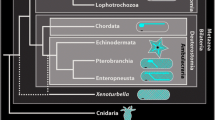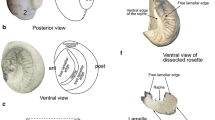Abstract
Olfactory crypt neurons have been observed in several bony fishes and chondrichtyans. Although their morphology is uniform in all fish, very few is known about their antigenic properties, usually studied in zebrafish, but quite overlooked in other species. We tested in Poecilia reticulata (guppy) the two antibodies recognized to mark zebrafish crypt cells: while anti-S100 showed an immunohistochemical pattern comparable to what reported in zebrafish, anti-TrkA gave no signal. Western blot analysis revealed that S100-antiserum bound an antigen of expected weight, probably belonging to the S100 family. On the contrary, anti-TrkA detected more bands, but the protein/s might be too much diffused and/or diluted in the tissue to be detected with immunohistochemistry. Because of the high level of conservation in the Trk family proteins of the kinase domain, on which anti-TrkA was produced, we also tested anti-TrkB to exclude cross reactivity. Immunohistochemistry and Western blot confirmed that anti-TrkB displayed high specificity to its target and a different staining pattern compared to anti-TrkA, but, as anti-TrkA, it did not label crypt neurons. Finally, we documented that calretinin, a known marker of zebrafish ciliated and microvillous olfactory cells, in the guppy is expressed also by a subpopulation of S100-positive crypt neurons. These results reveal differences in antigen expression between zebrafish and guppy crypt cells. Together with the already known species-specific projections to the olfactory bulb and a heterogeneous panel of odorants, our findings support the possibility that crypt cells are functionally less uniform as supposed.




Similar content being viewed by others
References
Ahuja G, Ivandic I, Saltürk M, Oka Y, Nadler W, Korsching SI (2013) Zebrafish crypt neurons project to a single, identified mediodorsal glomerulus. Sci Rep 3:2063–2071
Ahuja G, Bozorg Nia S, Zapilko V, Shiriagin V, Kowatschew D, Oka Y, Korsching SI (2014) Kappe neurons, a novel population of olfactory sensory neurons. Sci Rep 4:4037–4044
Arvedlund M, Munday PL, Takemura A (2007) The morphology and ultrastructure of the peripheral olfactory organ in newly metamorphosed coral-dwelling gobies, Paragobiodon xanthosomus Bleeker (Gobiidae, Teleostei). Tissue Cell 39(5):335–342
Bazáes A, Schmachtenberg O (2012) Odorant tuning of olfactory crypt cells from juvenile and adult rainbow trout. J Exp Biol 215:1740–1748
Bettini S, Lazzari M, Ciani F, Franceschini V (2009) Immunohistochemical and histochemical characteristics of the olfactory system of the guppy, Poecilia reticulata (Teleostei, Poecilidae). Anat Rec (Hoboken) 292(10):1569–1576
Bettini S, Lazzari M, Franceschini V (2012) Quantitative analysis of crypt cell population during postnatal development of the olfactory organ of the guppy, Poecilia reticulata (Teleostei, Poecilidae), from birth to sexual maturity. J Exp Biol 215(15):2711–2715
Bettini S, Lazzari M, Ferrando S, Gallus L, Franceschini V (2016) Histopathological analysis of the olfactory epithelium of zebrafish (Danio rerio) exposed to sublethal doses of urea. J Anat 228(1):59–69
Braubach OR, Fine A, Croll RP (2012) Distribution and functional organization of glomeruli in the olfactory bulbs of zebrafish (Danio rerio). J Comp Neurol 520(11):2317–2339
Castro A, Becerra M, Manso MJ, Anadón R (2006a) Calretinin immunoreactivity in the brain of the zebrafish, Danio rerio: distribution and comparison with some neuropeptides and neurotransmitter-synthesizing enzymes. I. Olfactory organ and forebrain. J Comp Neurol 494(3):435–459
Castro A, Becerra M, Manso MJ, Anadón R (2006b) Calretinin immunoreactivity in the brain of the zebrafish, Danio rerio: distribution and comparison with some neuropeptides and neurotransmitter-synthesizing enzymes. II. Midbrain, hindbrain, and rostral spinal cord. J Comp Neurol 494(5):792–814
Castro A, Becerra M, Anadón R, Manso MJ (2008) Distribution of calretinin during development of the olfactory system in the brown trout, Salmo trutta fario: Comparison with other immunohistochemical markers. J Chem Neuroanat 35(4):306–316
Catania S, Germanà A, Laurà R, Gonzalez-Martinez T, Ciriaco E, Vega JA (2003) The crypt neurons in the olfactory epithelium of the adult zebrafish express TrkA-like immunoreactivity. Neurosci Lett 350(1):5–8
Catania S, Germanà A, Cabo R, Ochoa-Erena FJ, Guerrera MC, Hannestad J, Represa J, Vega JA (2007) Neurotrophin and Trk neurotrophin receptors in the inner ear of Salmo salar and Salmo trutta. J Anat 210(1):78–88
Chakrabarti P, Ghosh SK (2011) Histological and ultrastructural studies of the olfactory epithelium of spotted butter fish Scatophagus argus (Linnaeus). Folia Morphol (Warsz) 70(2):74–79
D’Angelo L, de Girolamo P, Cellerino A, Tozzini ET, Castaldo L, Lucini C (2012) Neurotrophin Trk receptors in the brain of a teleost fish, Nothobranchius furzeri. Microsc Res Tech 75(1):81–88
Donato R, Cannon BR, Sorci G, Riuzzi F, Hsu K, Weber DJ, Geczy CL (2013) Functions of S100 proteins. Curr Mol Med 13(1):24–57
Farbman AI (2000) Cell biology of olfactory epithelium. In: Finger TE, Silver WL, Restrepo D (eds) The neurobiology of taste and smell. Wiley, New York, pp 131–158
Ferrando S, Bottaro M, Gallus L, Girosi L, Vacchi M, Tagliafierro G (2006) Observations of crypt neuron-like cells in the olfactory epithelium of a cartilaginous fish. Neurosci Lett 403(3):280–282
Gatta C, Altamura G, Avallone L, Castaldo L, Corteggio A, D’Angelo L, de Girolamo P, Lucini C (2016) Neurotrophins and their Trk-receptors in the cerebellum of zebrafish. J Morphol 277(6):725–736
Gayoso JÁ, Castro A, Anadón R, Manso MJ (2011) Differential bulbar and extrabulbar projections of diverse olfactory receptor neuron populations in the adult zebrafish (Danio rerio). J Comp Neurol 519(2):247–276
Gayoso JÁ, Castro A, Anadón R, Manso MJ (2012) Crypt cells of the zebrafish Danio rerio mainly project to the dorsomedial glomerular field of the olfactory bulb. Chem Senses 37(4):357–369
Germanà A, Montalbano G, Laurà R, Ciriaco E, del Valle ME, Vega JA (2004a) S100 protein-like immunoreactivity in the crypt olfactory neurons of the adult zebrafish. Neurosci Lett 371(2–3):196–198
Germanà A, González-Martínez T, Catania S, Laura R, Cobo J, Ciriaco E, Vega JA (2004b) Neurotrophin receptors in taste buds of adult zebrafish (Danio rerio). Neurosci Lett 354(3):189–192
Germanà A, Marino F, Guerrera MC, Campo S, De Girolamo P, Montalbano G, Germanà GP, Ochoa-Erena FJ, Ciriaco E, Vega JA (2008) Expression and distribution of S100 protein in the nervous system of the adult zebrafish (Danio rerio). Microsc Res Tech 71:248–255
Hamdani el H, Døving KB (2006) Specific projection of the sensory crypt cells in the olfactory system in crucian carp, Carassius carassius. Chem Senses 31(1):63–67
Hansen A, Finger TE (2000) Phyletic distribution of crypt-type olfactory receptor neurons in fishes. Brain Behav Evol 55(2):100–110
Hansen A, Zeiske E (1998) The peripheral olfactory organ of the zebrafish, Danio rerio: an ultrastructural study. Chem Senses 23(1):39–48
Hansen A, Zippel HP, Sorensen PW, Caprio J (1999) Ultrastructure of the olfactory epithelium in intact, axotomized, and bulbectomized goldfish, Carassius auratus. Microsc Res Tech 45(4–5):325–338
Hansen A, Rolen SH, Anderson K, Morita Y, Caprio J, Finger TE (2003) Correlation between olfactory receptor cell type and function in the channel catfish. J Neurosci 23(28):9328–9339
Hansen A, Rolen SH, Anderson K, Morita Y, Caprio J, Finger TE (2005) Olfactory receptor neurons in fish: structural, molecular and functional correlates. Chem Senses 30(Suppl 1):i311
Jullien J, Guili V, Reichardt LF, Rudkin BB (2002) Molecular kinetics of nerve growth factor receptor trafficking and activation. J Biol Chem 277(41):38700–38708
Kress S, Biechl D, Wullimann MF (2015) Combinatorial analysis of calcium-binding proteins in larval and adult zebrafish primary olfactory system identifies differential olfactory bulb glomerular projection fields. Brain Struct Funct 220(4):1951–1970
Lazzari M, Bettini S, Ciani F, Franceschini V (2007) Light and transmission electron microscopy study of the peripheral olfactory organ of the guppy, Poecilia reticulata (Teleostei, Poecilidae). Microsc Res Tech 9:782–789
Lazzari M, Bettini S, Franceschini V (2013) Immunocytochemical characterization of olfactory ensheathing cells in fish. Brain Struct Funct 218(2):539–549
Lazzari M, Bettini S, Franceschini V (2014) Immunocytochemical characterisation of olfactory ensheathing cells of zebrafish. J Anat 224(2):192–206
Llovera M, de Pablo Y, Egea J, Encinas M, Peiró S, Martín-Zanca D, Rocamora N, Comella JX (2004) Trk is a calmodulin-binding protein: implications for receptor processing. J Neurochem 88(2):422–433
Milani L, Maurizii MG (2015) Vasa expression in spermatogenic cells during the reproductive-cycle phases of Podarcis sicula (Reptilia, Lacertidae). J Exp Zool B Mol Dev Evol 324(5):424–434
Mitchell A, Chang H-Y, Daugherty L et al (2015) The InterPro protein families database: the classification resource after 15 years. Nucleic Acids Res 43:D213–D221
Oka Y, Saraiva LR, Korsching SI (2012) Crypt neurons express a single V1R-related ora gene. Chem Senses 37(3):219–227
Parisi V, Guerrera MC, Abbate F, Garcia-Suarez O, Viña E, Vega JA, Germanà A (2014) Immunohistochemical characterization of the crypt neurons in the olfactory epithelium of adult zebrafish. Ann Anat 196(4):178–182
Schmachtenberg O (2006) Histological and electrophysiological properties of crypt cells from the olfactory epithelium of the marine teleost Trachurus symmetricus. J Comp Neurol 495:113–121
Schwaller B (2014) Calretinin: from a “simple” Ca(2+) buffer to a multifunctional protein implicated in many biological processes. Front Neuroanat 8:3
Skaper SD (2008) The biology of neurotrophins, signalling pathways, and functional peptide mimetics of neurotrophins and their receptors. CNS Neurol Disord Drug Targets 7(1):46–62
van der Loos CM (2008) Multiple immunoenzyme staining: methods and visualizations for the observation with spectral imaging. J Histochem Cytochem 56(4):313–328
Vielma A, Ardiles A, Delgado L, Schmachtenberg O (2008) The elusive crypt olfactory receptor neuron: evidence for its stimulation by amino acids and cAMP pathway agonists. J Exp Biol 211(Pt 15):2417–2422
Zeiske E, Kasumyan A, Bartsch P, Hansen A (2003) Early development of the olfactory organ in sturgeons of the genus Acipenser: a comparative and electron microscopic study. Anat Embryol (Berl) 206(5):357–372
Author information
Authors and Affiliations
Corresponding authors
Additional information
S. Bettini and L. Milani contributed equally to the work.
Rights and permissions
About this article
Cite this article
Bettini, S., Milani, L., Lazzari, M. et al. Crypt cell markers in the olfactory organ of Poecilia reticulata: analysis and comparison with the fish model Danio rerio . Brain Struct Funct 222, 3063–3074 (2017). https://doi.org/10.1007/s00429-017-1386-2
Received:
Accepted:
Published:
Issue Date:
DOI: https://doi.org/10.1007/s00429-017-1386-2




